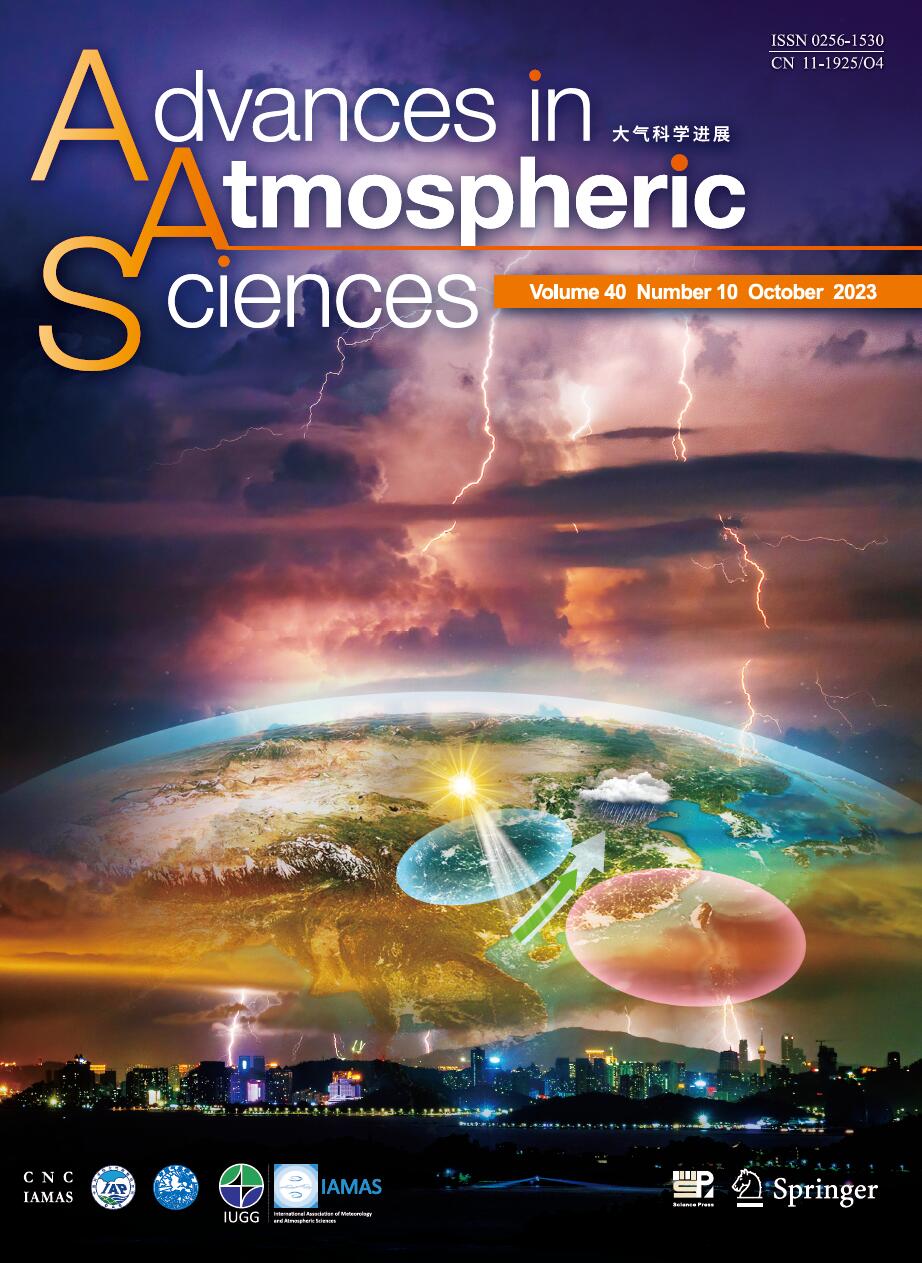| [1] |
Li Chongyin, Li Guilong,
1997: Evolution of Intraseasonal Oscillation over the Tropical Western Pacific / South China Sea and Its Effect to the Summer Precipitation in Southern China, ADVANCES IN ATMOSPHERIC SCIENCES, 14, 246-254.
doi: 10.1007/s00376-997-0023-z
|
| [2] |
HU Dingzhu, TIAN Wenshou, XIE Fei, SHU Jianchuan, and Sandip DHOMSE, ,
2014: Effects of Meridional Sea Surface Temperature Changes on Stratospheric Temperature and Circulation, ADVANCES IN ATMOSPHERIC SCIENCES, 31, 888-900.
doi: 10.1007/s00376-013-3152-6
|
| [3] |
HUANG Wenyu, WANG Bin*, LI Lijuan, DONG Li, LIN Pengfei, YU Yongqiang, ZHOU Tianjun, LIU Li, XU Shiming, XIA Kun, PU Ye, WANG Lu, LIU Mimi, SHEN Si, HU Ning, WANG Yong, SUN Wenqi, and DONG Fang,
2014: Variability of Atlantic Meridional Overturning Circulation in FGOALS-g2, ADVANCES IN ATMOSPHERIC SCIENCES, 31, 95-109.
doi: 10.1007/s00376-013-2155-7
|
| [4] |
HU Ruijin, LIU Qinyu, WANG Qi, J. Stuart GODFREY, MENG Xiangfeng,
2005: The Shallow Meridional Overturning Circulation in the Northern Indian Ocean and Its Interannual Variability, ADVANCES IN ATMOSPHERIC SCIENCES, 22, 220-229.
doi: 10.1007/BF02918511
|
| [5] |
DENG Shumei, CHEN Yuejuan, HUANG Yong, LUO Tao, BI Yun,
2011: Transient Characteristics of Residual Meridional Circulation during Stratospheric Sudden Warming, ADVANCES IN ATMOSPHERIC SCIENCES, 28, 551-563.
doi: 10.1007/s00376-010-0010-7
|
| [6] |
Wu Guoxiong, Stefano Tibaldi,
1987: THE EFFECTS OF MECHANICAL FORCING ON THE MEAN MERIDIONAL CIRCULATION AND TRANSFER PROPERTIES OF THE ATMOSPHERE, ADVANCES IN ATMOSPHERIC SCIENCES, 4, 24-42.
doi: 10.1007/BF02656659
|
| [7] |
Chen Ming, Hong Zhongxiang, Arnaldo Longhetto, Richiardone Renzo,
1996: Sensitivity Study of Nonlocal Turbulence Closure Scheme in Local Circulation, ADVANCES IN ATMOSPHERIC SCIENCES, 13, 147-158.
doi: 10.1007/BF02656858
|
| [8] |
Boyin HUANG, ZHU Jiang, YANG Haijun,
2014: Mechanisms of Atlantic Meridional Overturning Circulation (AMOC) Variability in a Coupled Ocean-Atmosphere GCM, ADVANCES IN ATMOSPHERIC SCIENCES, 31, 241-251.
doi: 10.1007/s00376-013-3021-3
|
| [9] |
YU Lei, GAO Yongqi, WANG Huijun, Helge DRANGE,
2008: Revisiting Effect of Ocean Diapycnal Mixing on Atlantic Meridional Overturning Circulation Recovery in a Freshwater Perturbation Simulation, ADVANCES IN ATMOSPHERIC SCIENCES, 25, 597-609.
doi: 10.1007/s00376-008-0597-0
|
| [10] |
Yuan Zhuojian, Wang Tongmei, He Haiyan, Luo Huibang, Guo Yufu,
2000: A Comparison between Numerical Simulations of Forced Local Hadley (Anti-Hadley) Circulation in East Asian and Indian Monsoon Regions, ADVANCES IN ATMOSPHERIC SCIENCES, 17, 538-554.
doi: 10.1007/s00376-000-0017-6
|
| [11] |
Chineke Theo Chidiezie, Li Weiping,
1999: IAP General Circulation Models: A First Step Towards Developing a Local Area Model for Weather Prediction in Nigeria, ADVANCES IN ATMOSPHERIC SCIENCES, 16, 119-132.
doi: 10.1007/s00376-999-0008-1
|
| [12] |
ZHOU Libo, ZOU Han, MA Shupo, LI Peng, ZHU Jinhuan, HUO Cuiping,
2011: Vertical Air Mass Exchange Driven by the Local Circulation on the Northern Slope of Mount Everest, ADVANCES IN ATMOSPHERIC SCIENCES, 28, 217-222.
doi: 10.1007/s00376-010-9231-z
|
| [13] |
Yiwen LI, Hailong LIU, Pengfei LIN, Eric P. CHASSIGNET, Zipeng YU, Fanghua WU,
2024: Quantifying the Role of the Eddy Transfer Coefficient in Simulating the Response of the Southern Ocean Meridional Overturning Circulation to Enhanced Westerlies in a Coarse-resolution Model, ADVANCES IN ATMOSPHERIC SCIENCES, 41, 1853-1867.
doi: 10.1007/s00376-024-3278-8
|
| [14] |
WU Shu, WU Lixin, LIU Qinyu, Shang-Ping XIE,
2010: Development Processes of the Tropical Pacific Meridional Mode, ADVANCES IN ATMOSPHERIC SCIENCES, 27, 95-99.
doi: 10.1007/s00376-009-8067-x
|
| [15] |
ZOU Han, LI Peng, MA Shupo, ZHOU Libo, ZHU Jinhuan,
2012: The Local Atmosphere and the Turbulent Heat Transfer in the Eastern Himalayas, ADVANCES IN ATMOSPHERIC SCIENCES, 29, 435-440.
doi: 10.1007/s00376-011-0233-2
|
| [16] |
WANG Huijun,
2005: The Circum-Pacific Teleconnection Pattern in Meridional Wind in the High Troposphere, ADVANCES IN ATMOSPHERIC SCIENCES, 22, 463-466.
doi: 10.1007/BF02918759
|
| [17] |
ZHU Jieshun, SUN Zhaobo, ZHOU Guangqing,
2007: A Note on the Role of Meridional Wind Stress Anomalies and Heat Flux in ENSO Simulations, ADVANCES IN ATMOSPHERIC SCIENCES, 24, 729-738.
doi: 10.1007/s00376-007-0729-y
|
| [18] |
He Jinhai,
1990: Discussion of Meridional Propagation Mechanism of Quasi-40-Day Oscillation, ADVANCES IN ATMOSPHERIC SCIENCES, 7, 78-86.
doi: 10.1007/BF02919170
|
| [19] |
Yonghong LIU, Bing DANG, Yongming XU, Fuzhong WENG,
2021: An Observational Study on the Local Climate Effect of the Shangyi Wind Farm in Hebei Province, ADVANCES IN ATMOSPHERIC SCIENCES, 38, 1905-1919.
doi: 10.1007/s00376-021-0290-0
|
| [20] |
Zhao Ming, Zeng Xinmin,
2002: A Theoretical Analysis on the Local Climate Change Induced by the Change of Landuse, ADVANCES IN ATMOSPHERIC SCIENCES, 19, 45-63.
doi: 10.1007/s00376-002-0033-9
|















 AAS Website
AAS Website 
 AAS WeChat
AAS WeChat 
 DownLoad:
DownLoad: